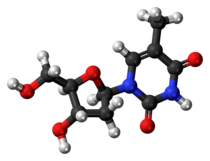
| |

| |
| Names | |
|---|---|
| IUPAC name
Thymidine
| |
| Systematic IUPAC name
1-[(2R,4S,5R)-4-Hydroxy-5-(hydroxymethyl)oxolan-2-yl]-5-methylpyrimidine-2,4(1H,3H)-dione | |
| Other names
Deoxythymidine, Td, dT, 1-[(2R,4S,5R)-4-Hydroxy-5-(hydroxymethyl)tetrahydrofur-2-yl]-5-methyl-1,3-dihydropyrimidine-2,4-dione
| |
| Identifiers | |
3D model (JSmol)
|
|
| ChEMBL | |
| ChemSpider | |
| DrugBank | |
| ECHA InfoCard | 100.000.065 |
| MeSH | Deoxythymidine |
PubChem CID
|
|
| UNII | |
CompTox Dashboard (EPA)
|
|
| |
| |
| Properties | |
| C10H14N2O5 | |
| Molar mass | 242.231 g·mol−1 |
| Melting point | 185 °C |
Except where otherwise noted, data are given for materials in their standard state (at 25 °C [77 °F], 100 kPa).
| |
Thymidine (symbol dT or dThd), also known as deoxythymidine, deoxyribosylthymine, or thymine deoxyriboside, is a pyrimidine deoxynucleoside. Deoxythymidine is the DNA nucleoside T, which pairs with deoxyadenosine (A) in double-stranded DNA. In cell biology it is used to synchronize the cells in G1/early S phase. The prefix deoxy- is often left out since there are no precursors of thymine nucleotides involved in RNA synthesis.
Before the boom in thymidine use caused by the need for thymidine in the production of the antiretroviral drug azidothymidine (AZT), much of the world's thymidine production came from herring sperm.[1] Thymidine occurs almost exclusively in DNA but it also occurs in the T-loop of tRNA.
- ^ Makoto Ishii; Hideyuki Shirae; Kenzo Yokozeko, Enzymatic Production of 5-Methyluridine from Purine Nucleosides and Thymine by Erwinia carotovora AJ-2992, Agricultural and Biological Chemistry